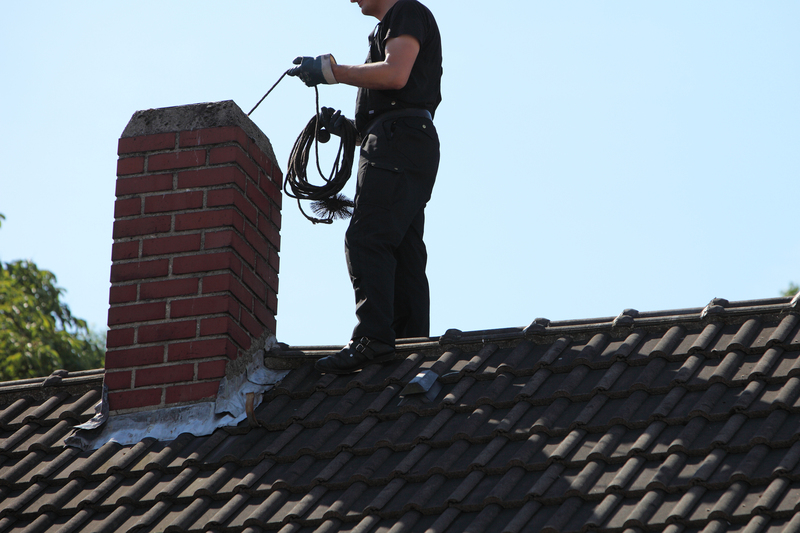Effortless End of Tenancy Cleaning: Guide for Smart Tenants
Posted on 05/06/2025
Effortless End of Tenancy Cleaning: Guide for Smart Tenants
Moving out can be stressful--between packing, logistics, and ensuring you leave the place spotless, there's a lot on your plate. That's where end of tenancy cleaning comes in. For smart tenants, handling this final task efficiently can help secure your full deposit and leave a good impression. In this comprehensive guide, we'll walk you through effortless end of tenancy cleaning so you can move out with peace of mind, save time, and impress your landlord.
What is End of Tenancy Cleaning?
End of tenancy cleaning refers to a thorough deep clean performed before moving out of a rented property. Most tenancy agreements require this, as landlords and letting agents expect the property to be left in a pristine state for the next tenants. Failing to follow through can result in deposit deductions.
In short, this process restores the property to its original, move-in condition.
Why is End of Lease Cleaning Important?
- Protects Your Deposit: Most landlords withhold a portion of the deposit if cleaning standards aren't met.
- Leaves a Good Impression: Future references from your landlord can be crucial for your next rental.
- Meets Legal Obligations: Many tenancy contracts stipulate this cleaning is mandatory.
- Makes Moving Easier for Everyone: The next tenants walk into a clean, welcoming space.

Preparation: Getting Ready for Move Out Cleaning
An effortless end of tenancy clean starts with smart preparation. Organise your approach in advance to streamline the whole process.
1. Check Your Tenancy Agreement
Some agreements specify what needs to be cleaned or call for "professional cleaning". Make a checklist based on these requirements.
2. Inspect the Inventory Report
Compare the property's current condition with the inventory report from your move-in day to note areas needing attention.
3. Gather Cleaning Supplies
Stock up on:
- All-purpose cleaner
- Disinfectant
- Glass and window cleaner
- Oven and kitchen cleaning sprays
- Microfiber cloths
- Mop, bucket, and vacuum
- Scrubbing brushes and sponges
- Limescale remover
- Bin bags and gloves
Having all supplies ready ensures your end of tenancy cleaning is seamless and efficient.
Room-by-Room End of Tenancy Cleaning Checklist
For smart tenants, breaking down the cleaning process by rooms makes the job manageable. Here's your step-by-step checklist:
Kitchen: The Priority Zone
- Oven and Hob: Remove baked-on grease and grime. Don't forget oven racks, trays, and knobs.
- Fridge/Freezer: Defrost, clean inside and out, eliminate food residues and odours.
- Microwave & Appliances: Wipe inside and outside, including washing machine and dishwasher filters.
- Worktops and Cupboards: Clean and disinfect surfaces and cabinet interiors.
- Sinks and Draining Boards: Remove limescale, polish taps and stainless steel.
- Floors & Tiles: Sweep, mop and scrub any stains.
Bathrooms: Hygiene Matters Most
- Toilets: Disinfect, scrub, and descale.
- Showers and Bath: Remove soap scum, mould, and limescale. Clean shower head and screens.
- Sink & Mirrors: Polish for a streak-free finish.
- Tiles & Grout: Use an anti-mould spray for grout and corners.
- Floors: Mop thoroughly, paying extra attention around sanitary areas.
Bedrooms and Living Areas: Don't Miss These Spots
- Carpets & Floors: Vacuum all carpets, mop hardwood or laminate flooring. Consider professional carpet cleaning for stains.
- Curtains & Blinds: Dust, vacuum, or launder if necessary.
- Wardrobes & Drawers: Empty and wipe, paying attention to any marks or debris.
- Light Fixtures and Switches: Dust and disinfect for a polished look.
- Walls & Skirting Boards: Remove marks with a damp cloth.
Windows and Doors
- Clean glass, frames, and ledges inside and out where possible.
- Wipe down doors, especially handles and edges.
Expert Tips for Effortless End of Lease Cleaning
- Start from the Top Down: Dust and clean high places first. Gravity helps, so any falling dust gets cleaned in the final sweep.
- Work to a Plan: Schedule cleaning tasks over several days instead of doing it all at once.
- Declutter First: Remove your belongings before starting--this reveals hidden dirt and speeds up cleaning.
- Use the Right Products: Harsh chemicals can damage surfaces; always check manufacturer guidance for appliances and flooring.
- Tailor Your Cleaning: Don't waste time on areas that weren't clean at move-in--refer to your inventory report to stay on track.
- Don't Forget Fixtures and Fittings: Check behind sofas, under beds, and behind appliances for dust or rubbish.
Common Mistakes Tenants Make (and How to Avoid Them)
- Overlooking Hidden Areas: Clean behind and inside appliances, under furniture, above cupboards, and light switches.
- Not Cleaning to Inventory Standards: Use the move-in report as your guide, not just personal standards of "clean".
- Ignoring Stains or Damage: Attempt to fix minor issues yourself, or notify your landlord early about unavoidable damage.
- Leaving Waste Until the Last Minute: Dispose of rubbish and unwanted items before cleaning.
- Forgetting to Book Professional Cleaners: If the agreement calls for "professional cleaning", supply invoices as proof.
How to Pass Your Final Inspection
- Schedule the Inspection: Arrange a convenient time with your landlord or agent after you've completed your clean.
- Be Present for the Walkthrough: This allows you to answer questions or rectify something on the spot.
- Take Photos: Document the property after cleaning as evidence of its condition.
Smart tenants know: proactive communication and thorough cleaning prevent disputes over your deposit.
DIY vs Professional End of Tenancy Cleaning
Should You Clean Yourself or Hire a Professional?
Deciding between DIY end of lease cleaning and hiring experts depends on:
- Your available time
- The property size and level of cleanliness required
- Whether the tenancy agreement requires professional cleaning
- Your own cleaning expertise!
Pros of DIY End of Tenancy Cleaning
- Cost-saving
- Complete control over the process
Cons of DIY
- Takes significant time and effort
- Risk of missing spots--may result in deposit deductions
- No professional proof for the landlord
Advantages of Professional End of Tenancy Cleaners
- Guaranteed standard: Most offer satisfaction guarantees or re-cleans if the landlord is unsatisfied
- Specialist equipment and expertise, especially for ovens and carpets
- Freeing up your time to focus on your move
- Professional invoice for your records
Cost of End of Tenancy Cleaning
The cost varies based on property size, condition, and location. Typically:
- A studio flat: ?90 - ?150
- One-bedroom flat: ?120 - ?200
- Two-bedroom property: ?180 - ?250
- Three-bedroom house: ?240 - ?350+
Investing in professional end of tenancy cleaning can often be cost-effective when weighed against possible deposit deductions.
Tips for Booking a Professional End of Tenancy Clean
- Get recommendations or check reviews online
- Ask for a detailed breakdown of what's included--ensure all rooms and key areas are covered
- Book early, especially during peak moving seasons
- Make sure the company offers a satisfaction guarantee or the ability to re-clean if the landlord demands it
Eco-Friendly End of Tenancy Cleaning
Being a smart, eco-conscious tenant means opting for green cleaning solutions and reducing your environmental impact.
- Use biodegradable, non-toxic cleaning products
- Repurpose household staples like vinegar (degreaser), baking soda (scrub), and lemon (freshener)
- Recycle packaging and old sponges/cloths responsibly after use
This approach not only protects the planet, but it's often gentler on property fixtures and finishes too!

What Happens If You Don't Clean Properly?
Landlords are within their rights to arrange for additional cleaning and deduct the charges from your deposit. Failure to complete adequate move-out cleaning can also impact your rental reference and future ability to rent.
- You may lose part or all of your deposit
- Agents may charge a premium for arranging last-minute professional cleans
- Poor references can affect future tenancies
Final Summary: End of Tenancy Cleaning - A Smart Tenant's Secret Weapon
Your end of tenancy cleaning doesn't need to be stressful or drag on for days. With the right preparation, a solid checklist, smart cleaning hacks, and (if necessary) help from the professionals, you can hand back your rental property in pristine condition and swiftly reclaim your deposit. For the smart tenant, this is one of the easiest wins at the end of a lease.
- Start early and plan your cleaning in advance
- Use your inventory and tenancy agreement as your checklist
- Don't skip the details--hidden areas matter most
- Go green where you can for better results and a lighter footprint
- Consider professional help if you lack the time or tools
Effortless end of tenancy cleaning isn't just about satisfying your landlord--it's about leaving your old home better than you found it, starting your next chapter on the right foot, and keeping 100% of your deposit where it belongs: in your pocket!
Other Popular Questions About End of Tenancy Cleaning
- Can my landlord force me to use a professional cleaner?
If your tenancy agreement specifies "professional cleaning," then yes, you must provide a receipt. - How long does end of tenancy cleaning take?
DIY: Anywhere from 6-15 hours depending on size. Professionals: Usually 3-8 hours with a team. - What happens if I can't get a stain out?
Attempt a fix with safe cleaners. If unsuccessful, notify your landlord to discuss solutions.
Ready to ace your end of lease clean? With this smart tenant's guide, your move-out will be swift, your deposit safe, and your landlord thoroughly impressed. Good luck and happy moving!




